Abstract
The triple anniversary in 2020 of Thomas Becket’s birth, death and translation has been an occasion to review and revisit many of the artefacts associated with the saint and his cult in England and across Europe. Many of these are items directly associated with his veneration in churches or in private devotions, but one object which served in neither capacity is an instrument case currently in the collection of the Worshipful Company of Barbers in London. This unusual object has been studied for its fine silver work, and possible royal associations, but little academic attention has so far been paid to the some of the iconography, particularly that of the scene of the murder of Thomas Becket depicted on the back of the box, the side to be worn against the body. In this article, we show how seemingly unusual elements in the iconography draw on particularly Flemish representations of Becket’s murder that, to date, have received little attention in Anglophone scholarship. From this, we discuss this scene and its significance in understanding the role the iconography may have been intended to serve, and the interplay between the decorative schema and what the surgeon thought about his own role with regard to the use of the case and its tools.
Keywords:
instrument case; Thomas Becket; iconography; Barber Surgeon; silver; Netherlandish; medicine 1. Introduction
The triple anniversary in 2020 of Thomas Becket’s birth, death and translation has been an occasion to review and revisit many of the artefacts associated with the saint and his cult in England and across Europe. Many of these are items directly associated with his veneration in churches or in private devotions, but one object which served in neither capacity is an instrument case currently in the collection of the Worshipful Company of Barbers in London. This unusual object has been studied for its fine silver work, and possible royal associations, but little academic attention has so far been paid to the some of the iconography, particularly that of the scene of the murder of Thomas Becket depicted on the back of the box, the side to be worn against the body. In this article, we show how seemingly unusual elements in the iconography draw on particularly Flemish representations of Becket’s murder that, to date, have received little attention in Anglophone scholarship. From this, we discuss this scene and its significance in understanding the role the iconography may have been intended to serve, and the interplay between the decorative schema and what the surgeon thought about his own role with regard to the use of the case and its tools.
2. Materials and Methods: The Instrument Case, Historiography, and Approach
The case is a tapering box with removable lid, of silver, silver gilt, and enamel with a leather and wood lining, 18 cm in height, 6 cm in width, and 5 cm in depth [Figure 1 and Figure 2—Image of the box]. It was designed to be attached to a surgeon’s belt by a silver chain which passes through lions-head loops on the sides of the box and cover. The interior is divided into sections by wood and leather partitions. The box is highly decorated, with silver figures of saints on the front and engraved silver panels on the sides and rear. The known history of the case has been outlined in an article by Ann Wickham. There is no record of it prior to 1922, when it was found in a box of ‘junk’ at the London saleroom of the auctioneer William Edward Hurcomb. It passed briefly through the hands of two antique jewellery firms, before it was purchased in 1923 by Viscount Lee (Wickham 2002, pp. 90–91). On his death in 1955, his widow presented the case to the Worshipful Company of Barbers. While it has largely remained in the private collection of the Company of Barbers since then, the case has recently been featured in the British Museum’s 2021 exhibition ‘Thomas Becket: Murder and the Making of a Saint’, once again bringing it to wider attention (De Beer and Speakman 2021, pp. 212–13).
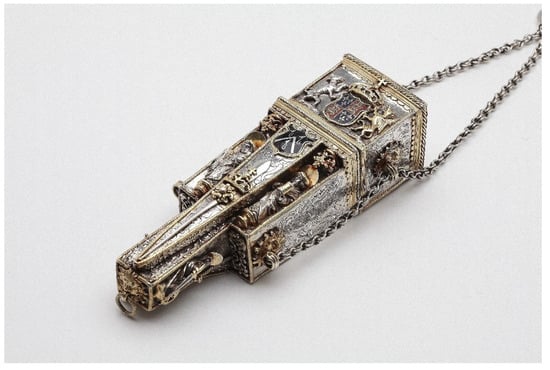
Figure 1.
Instrument case, front. From the collections of the Worshipful Company of Barbers, London.
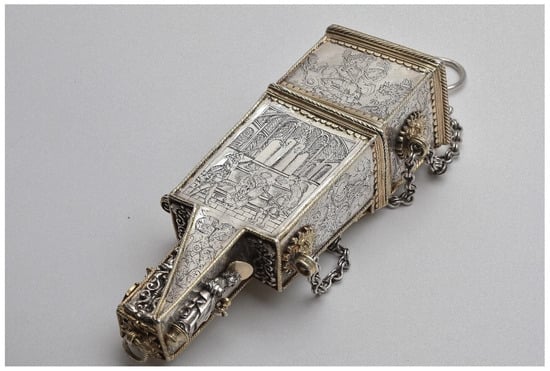
Figure 2.
Instrument case, rear. From the collections of the Worshipful Company of Barbers, London.
This exquisite silver item has attracted some academic attention, mainly focusing on its craftsmanship, date, and attempting to identify potential patrons, recipients, and artists involved in its manufacture. Beginning with the 1931 article by Charles J. S. Thompson, curator of the Wellcome Institute and the Royal College of Surgeons’ museum, historians have dated the object through an analysis of the royal arms in particular. From Thompson onwards a terminus ante quem of 1525 for the case seemed to be provided by the royal arms featuring dragon and greyhound supporters, the latter being replaced by a lion in that year (Thompson 1931, p. 811; Dobson and Walker 1979, pp. 106–7; Wickham 2002, pp. 85–87). Recently Timothy Schroder has shown that other elements of the decoration cannot predate 1527, arguing that the greyhound continued in use after 1525, and thus providing a date of c. 1530 for the case (Schroder 2020, p. 177). The royal arms have also pointed to connections with the royal court, with most historians agreeing that the piece would have been a royal commission for one of the king’s personal physicians. Another historiographical debate around the item has been its place of manufacture, with both Wickham and Schroder concluding that it was made in London, although Schroder argues the Netherlandish elements point to it being made by foreign craftsmen in the city (Wickham 2002, pp. 88–89; Schroder 2020, p. 178).
In our analysis of the case, we focus on the iconography of Becket’s murder on the back panel, and use this as an avenue to explore questions of function and use. Historians have concluded that the case would have had a purely ceremonial function, but we argue strongly against this assumption (Thompson 1931, p. 811; De Beer and Speakman 2021, p. 213). We explore the decoration and ornament of the case as integral to it, and vice versa the function of the case as directly informing the ornamentation. As such, we attempt to move away from positivist art-historical considerations of identifying artist and patron, production techniques and influences, and instead, following James H. Marrow’s suggestion, we attempt to appreciate how the piece in the context of its manufacture and use would ‘elicit interest, structure understanding, and communicate meaning’ (Marrow 2006, p. 164). We consider the design strategies discernible in the case as a whole, inevitably necessitating a reconsideration of the context of its manufacture. We also look at how the artist of the Becket panel drew on a range of techniques and stylistic influences to represent a well-known scene in a manner that offered a deeper and potentially new understanding of its significance to the user and viewer of the case.
3. Form and Function
The instrument case was of a type known as a plaster box. It was designed to be hung from the surgeon’s belt to hold some of his precision tools while performing operations. The interior is lined with leather and wood, and the interior divided into sections capable of holding six or seven smaller instruments, suggested to have been a large scalpel, forceps, scissors, lancets, and probes (Thompson 1931, p. 811; Wickham 2002, pp. 85–86). A very similar box, albeit much plainer, can be seen amongst the selection of instruments portrayed in Hieronymus Brunschwig’s Buch der Cirurgia of 1497, on the right-hand side of the woodcut [Figure 3]. The Barber Surgeons’ case also has a protective leather or ‘cuir bouile’ carrying-case, probably contemporaneous with the case itself, which is simply decorated with foliate scrolls and incised lines in the manner of the Brunschwig image, or in the manner of that shown resting on top of the surgeon’s box in the frontispiece illustration to the 1559 edition of Walther Hermann Ryff’s Groß Chirurgei (Wickham 2002, p. 86) [Figure 4]. Another woodcut of surgical instruments often included in editions of Johannes de Ketham’s Wudartznei (surgery book) in the 1530s shows a box with its lid raised, revealing the handle-tips of the instruments it contains, among which it is possible to discern the handles of scissors and forceps and the ends of needles and lancets [Figure 5]. Similarly another illustration from Ryff’s Groß Chirurgei shows a box covered in engraved ornament, opened to show compartments containing scissors, lancets, needles, a syringe, and plasters [Figure 6].
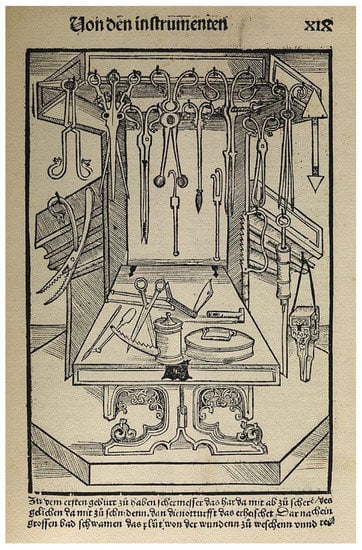
Figure 3.
Surgical tools including an instrument case (far right). Hieronymus Brunschwig, Buch der Cirurgia (Strasbourg: Johann Grüninger, 1497), fo. 17r. Munich, Bayerische Staatsbibliothek—2 Inc.c.a. 3452.
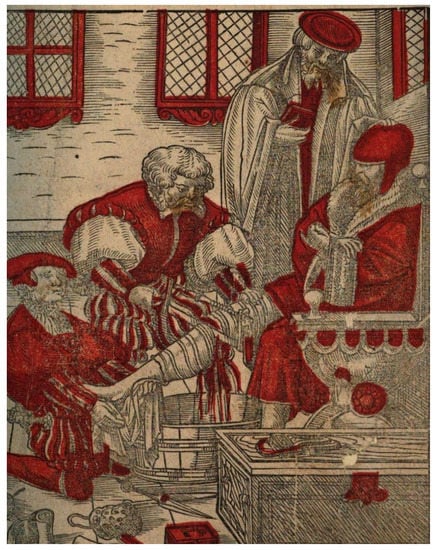
Figure 4.
A surgeon performs a leg amputation. His instrument case is on top of his surgeon’s box, bottom right. Walther Hermann Ryff, Groß Chirurgei: oder volkommene Wurdartznei (Frankfurt am Main: Egenolff 1559) frontispiece. Augsburg, Staats- und Stadtbibliothek—4 Med 1012.
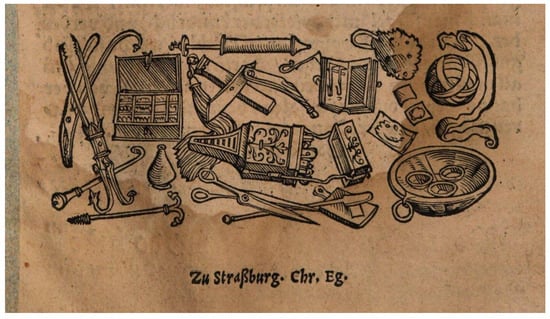
Figure 5.
Precision surgical instruments including an instrument case (centre) with the lid detached. Johannes de Ketham, Wurdartznei: Zu allen Gebrechen des Gantzen Liebs (Strasbourg: Eg[enolff], 1530), frontispiece. Munich, Bayerische Staatsbibliothek—Res/4 Chir. 110,1.
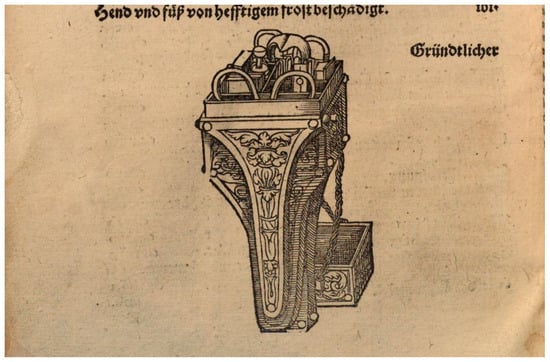
Figure 6.
A surgical instrument case with the lid detached, showing the contents. Walther Hermann Ryff, Groß Chirurgei: oder volkommene Wurdartznei (Frankfurt am Main: Egenolff 1559) p. [xii]. Munich, Bayerische Staatsbibliothek—Res/4 Chir. 110,1.
The high degree of ornamentation and use of precious metals on the Barber-Surgeons’ instrument case has led to the suggestion that it was intended for ceremonial use only (Thompson 1931, p. 811). Yet, practical surgical instruments of the later medieval and early modern period were often also elaborately decorated, high-status objects (Hartnell 2017, pp. 34–36). The surgeon’s tools showed him to be an artisan and craftsman, and marked him out as a professional of high social standing amongst his fellow burgesses and citizens. In the fifteenth and sixteenth centuries, the surgeons and barber-surgeons, whose Companies were not amalgamated until 1540, were highly conscious of a need to promote their claim to social prominence and respectability. This was particularly keenly felt in their social relationship to other medical practitioners and, in light of their special status as medical craftsmen rather than medical theorists, to London’s artisanal classes (Colston and Ralley 2015, pp. 1103–26; Wear 2000, p. 124; Decamp 2016, pp. 3–21; Pelling 1986). Wills of sixteenth-century barber-surgeons of London frequently bequeath instruments of silver and gold, including ‘one of my Launcetts that is sett in gold and enamyled’ (Young 1890, p. 530). It is not unreasonable to think that this instrument case was indeed used during surgery on particularly high-status individuals, reflecting the honour due to the patient and showing the eminence of the surgeon. The instruments in the case were used for delicate and cosmetic operations, and as the frontispiece of the 1559 edition of Ryff’s Groß Chirurgei shows, the case could be set aside when the surgeon was engaged in the more physical and brutal aspects of his trade, in this case on top of the surgeon’s tool chest as he amputates a client’s leg with a bone saw [Figure 4]. The back of the Barber-Surgeons’ case, particularly on the panel depicting Becket’s murder, shows two deep indentations, at the mid-point and bottom of his chasuble, which are almost certainly percussion marks worn into the silver by repeated contact with a belt buckle.
The Barber-Surgeons’ instrument case is completely covered in ornamentation, in an iconographical scheme that Timothy Schroder has noted is ‘very complex’ (Schroder 2020, p. 177). The arms of the Barbers Company (three fleams separated by a chevron) granted in 1451 are displayed under the royal arms, and below that the cognisance of the Fellowship of Surgeons (a ‘spater’ charged with a rose crowned) granted in 1492 (Dobson and Walker 1979, pp. 106–7). The arms are flanked by the patron saints of the barber-surgeons, Cosmas and Damian. On the sides of the bottom section are Sts Catherine and John the Evangelist, the latter also a patron of the medical profession. The presence of St Catherine may be a nod to the king’s then wife, Catherine of Aragon, although Catherine was also a very popular saint in late medieval London. Turning the object over, the back is covered with two engraved silver panels. The smaller, topmost, one shows St George slaying the dragon [Figure 7]. The panel which covers the main body of the case is an image of the martyrdom of St Thomas Becket [Figure 8]. These are the focus of the discussion below. At the top of the front of the case the royal arms, with dragon and greyhound supporters, and the Tudor rose on the lid point to an association with the royal court. Schroder suggests, from the form of the royal arms and the decorative side panels based on 1527 prints by Heinrich Aldegrever, that this may have been a gift from Henry VIII to his surgeon Thomas Vicary, appointed to the court in 1527 (Schroder 2020, p. 176; Thomas 2006). It is also feasible that Vicary commissioned the case to reflect his own new position. At the simplest level, this would offer an initial reason for the inclusion of Becket imagery on the piece, linking Thomas the saint to Thomas the surgeon. The case may even appear in Vicary’s will of 1562, as his ‘best plaister box, garnisshed with silver’, given to Thomas Bayley, Master of the Barber-Surgeons in 1559 (TNA, PROB 11/4/86; Schroder 2020, p. 337).
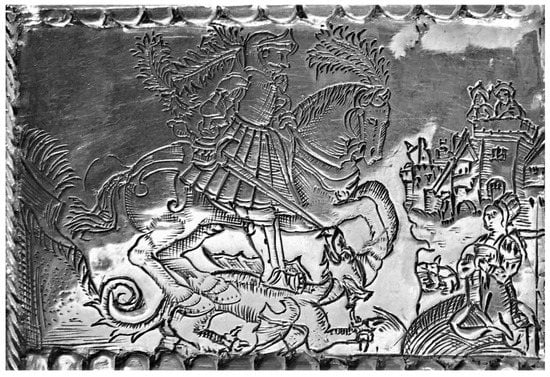
Figure 7.
Closeup of the St George panel from the top rear of the Barber Surgeon’s instrument case. Worshipful Company of Barbers.
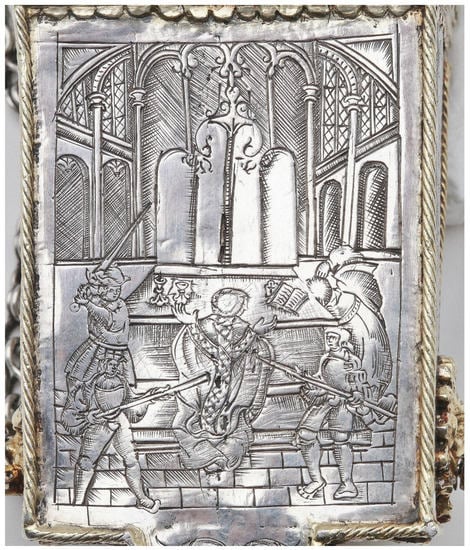
Figure 8.
Closeup of the Thomas Becket panel from the centre of the Barber Surgeon’s instrument case. Worshipful Company of Barbers.
The decorative and iconographic schemes on surgical tools were often closely tied to the instrument’s function. For example, ‘biting’ tools such as bone-saws featured animal heads posed in the act of biting, and the instrument case similarly features lions’ heads biting onto rings on its sides and base. The importance of appropriate decorative elements to the instrument’s overall function was such that instruments were sometimes ornamented to the extent that the embellishments would actually impede their immediate surgical functionality, becoming snagged on clothing or flesh (Hartnell 2017, pp. 44–50). The figures of the medical saints on the instrument case pointed to the religious protection and blessings bestowed on the user and the patient, but they obtrude from the surface and could potentially become snagged in clothing. Other decorative elements reflect the case’s function. The ‘spater’ (a general term applied to cutting or lancing tools) on which the rose of the Surgeon’s Fellowship was charged on the instrument case is depicted as a lancet at close to actual size, and a similar instrument would probably have been part of the contents. A lancet of this type is depicted in use in the c.1425 St William window in York Minster CVMA nVII panel 18a, where a surgeon is performing a procedure on a patient [Figure 9]. Of the rear panels, which would be against the body of the surgeon, the engraving of St George and the Dragon tied into the courtly status of the object, as he was England’s patron saint and particularly associated with the royal dynasty. Henry VIII had St George engraved on his own armour. He was also associated with healing and physical regeneration, and invoked as protection against sudden death and disease, although this was more of an aspect of his cult on the Continent, and particularly in Germany, than in England (Good 2009, pp. 88–93, 104, 123). St Thomas Becket had similarly long been one of England’s patron saints and since his murder in 1170 one that was particularly associated with healing, with pilgrims to his shrine able to purchase souvenirs bearing the legend OPTIMUS EGRORUM MEDICUS FIT TOMA BONORUM (Thomas is the best doctor of the worthy sick) (Spencer 1998, pp. 44–53). The images and embellishments were clearly carefully chosen to reflect the status and role of the wearer and the function of the case itself.
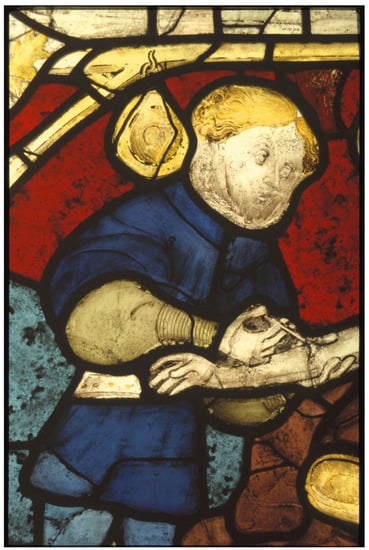
Figure 9.
A surgeon uses a lancet. From the St William Window of c. 1425, York Minster CVMA nVII panel 18a.
Schroder notes that the instrument case would almost certainly have been a collaborative piece, between a plate worker, enameller, and engraver. We might add that the contents of the case, no doubt of a similar quality, would have also required collaboration with a skilled manufacturer of precision tools. Previous studies of the case have suggested that it would have been made in London. Wickham thought the case was English and possibly made by the royal goldsmiths, whereas Schroder argued that it was made in London but probably by or under the supervision of ‘stranger’ (i.e., non-English) craftsmen (Schroder 2020, p. 178; Wickham 2002, pp. 86–87). It was more usual when commissioning work in precious metals to import craftsmen than finished products, although gold- and silverware was also shipped into London from the Low Countries in the 1520s. London was a centre for collaborative artistic production at workshops staffed by transient artisans, many of which were on their wanderjahr, making it difficult to pinpoint the origin of items such as the instrument case (Berry 2021; Curd 2010, pp. 1–72; Woods 2007).
A number of features point to the artwork of the case having been produced by Continental artisans. Besides the Aldegrever-inspired plates on the side, the clothing of Becket’s murderers, and the architectural form of the cathedral in which the murder takes place are all distinctly Netherlandish. A sketch, possibly by the Aldegrever school, in a mid-sixteenth century German ‘Jeweller’s Pocket Book’ and dated to 1530 is very similar to the patterns found on the sides of the instrument case [Figure 10]. Aldegrever’s prints were widely used by artists and craftsmen, as discussed by Rowlands (Rowlands 1988). The earliest references in English to ‘plaster boxes’ as part of the surgeon’s instrument set come from the mid-16th century, and as images of them only appear in Continental texts up to this time it may be that this intricate multi-purpose surgical kit, and the precision surgical tools it would have contained, was in the 1520s associated with production in the Low Countries and Germany1. It was common in the early-sixteenth century for a single contractor to organise the creation of complex works of art, including illuminated manuscripts, which required assembling a team of skilled craftsmen, even forming ad hoc workshops for bespoke pieces. (Van der Stock 2006, pp. 118–21; Curd 2010, pp. 21–27). The centre of this artisanal production was Antwerp ‘the commercial metropolis which boasted an exceptional art market’ (Koldeweij 2005, p. 43). The production of commissioned and ready-made altarpieces, for example, was closely controlled by the St Luke’s Guild of Antwerp as a way of coordinating the output of different ateliers and guaranteeing quality, and a document of 1460 states that the Antwerp Pand was explicitly constructed ‘in order to display for sale books, paintings, sculpture and joinery’ as well as tapestry, printing and other crafts (Jacobs 1998, pp. 158–59, 165). This is the artistic and commercial environment with which the makers of the case would have been familiar, whether working in the Low Countries or as emigres working in England.
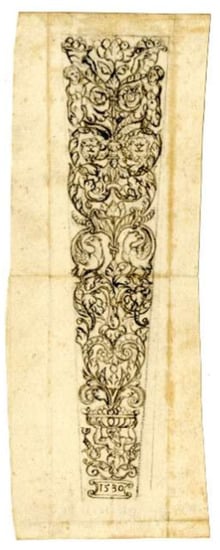
Figure 10.
Design for a panel in the style of Heinrich Aldegrever, from the ‘Jeweller’s Pocket Book’ 1530. British Museum 1978, 1216.51.
The art production of the Low Countries and Flemish artists both there and on their wanderjahr in the later fifteenth and early sixteenth century was undergoing something of a transformation. Jacobs (Jacobs 1998, p. 54) has commented on the increased taste for narrative in Netherlandish carved altarpieces in the late fifteenth and early sixteenth centuries, while the ‘lively market’ (Koldeweij 2005, p. 46) for small, illuminated books of hours for private devotion meant that attention to detail and a representation in which the viewer was a participant and not merely a passive observer became the order of the day. As we shall argue, this is an important factor in the depiction of Becket’s martyrdom on the instrument case. The highly collaborative atmosphere (Koldeweij 2005, p. 43) in which studios and artists in different media worked together on prestige projects is exactly the sort of environment in which the case would have been produced and the detail of the narrative developed. This shift in taste towards greater elaboration of the narrative content allowed carvers of altarpieces, for example, to develop and elaborate on scenes and details whilst remaining within the overall constraints of convention. For example, the development of detailed depictions of the apocryphal death of Joseph, the husband of the Virgin Mary, began to appear chronologically situated in between relevant Biblical narratives. Likewise, an increased interest in and use of the liturgical and didactic function of these altar pieces within the celebration of the Mass led to greater narrative depictions and increased interest in allegorical representations of the elements of the Mass, with form and function informing each other (Jacobs 1998, pp. 62–63). This development in altarpiece carving also appears in the increased range of narrative interpretation in other areas of art such as mystery plays in which the core narrative is embellished and developed to engage the viewer and connect them with the action on stage.
While the case was clearly made for an English patron connected with the royal court, possibly Vicary, who would have instructed the artists, probably through a middle-man, of his wishes for the iconographical composition of the case, a number of curious features in the execution of the iconographical scheme point to the artists being unfamiliar with the contemporary court style. This may even point to a Netherlandish origin for the instrument case itself. One of the iconographical elements which has caused difficulties in dating since it first came to light in the 1920s is the royal arms on the front. These have dragon and greyhound supporters, which were officially supplanted by the dragon and unicorn in 1525, thus apparently giving a terminus ante quem for the piece. As Schroder points out, however, the use of Aldegrever prints as the side panels give a terminus post quem of 1527 (Schroder 2020, p. 177). The dragon is also heraldically incorrect, being gold (or) rather than red (gules) (Wickham 2002, p. 85). While Schroder claims that the greyhound continued in use as a royal supporter after 1525, it is unlikely that a piece of this quality and in other ways striking modernity would have used the antiquated arms, especially if it was produced in the ambit of the court. A piece commissioned from the Low Countries, on the other hand, may have been more likely to make such small technical errors in contemporary royal heraldry.
In addition to this, the iconography of the upper panel on the rear, depicting St George slaying the dragon, points to an origin outside England. The panel itself is of an inferior artistic quality to the larger Becket panel which forms the basis for the rest of this article. The engraving is stiff and mannered, with cartoonish elements in some of the facial details and the background. The piece may well have been based on a pre-existing pattern drawing, as there are very clear similarities of composition with the frontispiece woodcut to Alexander Barclay’s 1515 Life of St George [Figure 11]. However, on the instrument case St George does not bear his arms, the red cross on white background, that were also the arms of England, and which in the Barclay engraving appear prominently on both his chest and his shield. St George’s breastplate cross is a clear feature of the ‘George Noble’ coin of 1526, as well as on the depictions of the saint on Henry VIII’s own armour of 1514/15, linking the saint to the flag of the English nation. It is perhaps unlikely that a piece engraved in England would omit this detail, key to the promotion of national identity around the king and his realm, whereas Renaissance Continental depictions of the saint do not always show his red and white cross livery (Good 2009, pp. 52–94, 123–24; Riches 2000).
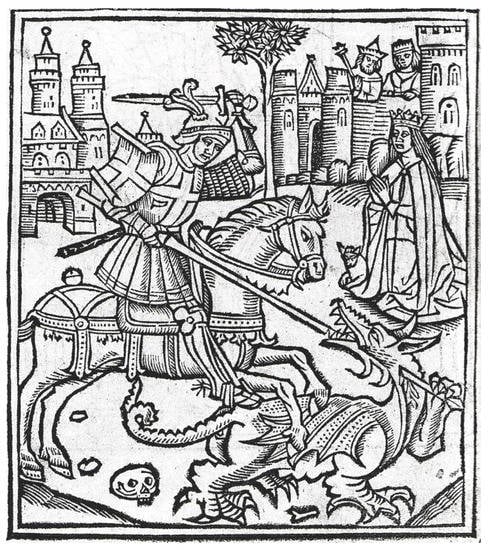
Figure 11.
Woodcut of St George and the dragon. Alexander Barclay, Life of St George (London: Richard Pynson, 1515) frontispiece.
4. Becket in the Low Countries: Devotion, Myth, and Iconography
Even if the instrument case was produced in England, the form of the iconography points clearly to the rear panels being the work of a Flemish artist, and needs to be understood in the context of Continental, and particularly Flemish, developments in how Becket’s martyrdom was portrayed in the later Middle Ages. Of particular relevance to a Low Countries origin either for the case itself or the engraver is an understanding of the development of a distinct Becket iconography in Flemish manuscript miniature paintings of the fifteenth century. Art-historical studies of Becket, particularly in English, have tended to focus on high medieval images from England, France, and Italy, the places where his cult flourished most strongly in the early years. For most of the medieval iconography of the martyrdom cult of St Thomas, the ‘standard’ view was for it to be depicted from the side, with the knights rushing in from stage left and Becket kneeling before an altar, his head or neck being sliced by one of the swords and (in some images) his mitre or skullcap, blood, skull and brains splattering to the ground (Borenius 1932, pp. 70–104; Duggan 2020). This is the scene which appears on the Limoges caskets which circulated in thirteenth-century Europe and is the scene which appears in the earliest images of Becket’s martyrdom, such as the early thirteenth-century manuscript BL Harley MS 5102 [Figure 12]. Edward Grim, the clerk who both witnessed the murder and had his arm hewn by one of the knights while attempting to intervene, was variously depicted at the side of the altar or defending Becket (Gameson 2000). In later depictions, Grim’s role became more passive, as the emphasis on Becket as an undefended martyr unexpectedly murdered whilst celebrating Mass became the trope, rather than someone cut down after a violent argument as relayed in the earliest hagiographies. It is possible that the elongated rectangle which formed the side piece of the typical reliquary casket encouraged this perspective in the depiction, in the same way that depictions of scenes within the Nativity of Christ, such as the Magi arriving at the court of Herod, or kneeling before the Christ-child, were likewise arranged to be viewed from the side. Such an arrangement adds to the sense of a narrative being ‘read’ from one side to the other, instilling the image with an, albeit brief, sense of the passage of time. The figures arrive and an event happens: an audience is sought, gifts are given, or knights attack. A particularly grisly early fifteenth-century example is in Canterbury Cathedral on a painted panel on the tomb of Henry IV, reproduced in the 1930s by E.W. Tristram [Figure 13]. Here, the slice of skull and associated brain matter are clearly visible on the steps, and Edward Grim stands horrified and wounded behind the altar.
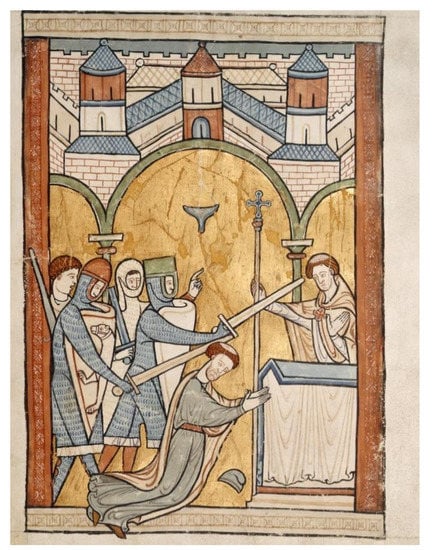
Figure 12.
The martyrdom of Thomas Becket, by an English or French artist c. 1175 × 1200, British Library, London, Harley MS 5102 fo. 32r.
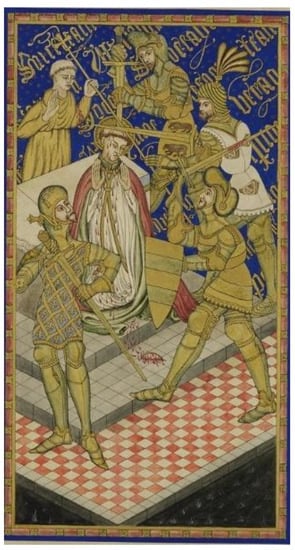
Figure 13.
The martyrdom of Thomas Becket, from the tester of the tomb of Henry IV, Canterbury Cathedral c. 1413. Canterbury Cathedral Archives, CCA-DCc-PRINDRAW/2/M/3.
Such is the development of the form in English medieval religious art. Yet, the Continental developments of Becket iconography in the later Middle Ages have received far less attention, certainly in Anglophone historiography. An important study in this regard is the collection of essays Thomas Becket in Vlaandren, produced to accompany a 2000 exhibition of Becket’s presence, both in person and in the form of his cult, in and around the Low Countries at Kortrijk Museum. There was certainly a marked devotion to Becket in the region. Many major abbeys possessed relics, including parts of Becket’s sandal and some of his blood which was brought to Egmond Abbey before 1215, and the Abbey of St. Nicholas-des-Prés of Saint-Médard, near Doornik, claimed to hold Becket’s chasuble as a relic. His blood-spattered surplice was given to the Abbey of Saint-Josse de Dommartin in Tortefontaine by a hermit shortly after the murder, which then became an important Becket pilgrimage destination in the Low Countries. A collection of miracles performed by Becket in association with the surplice relic was compiled at the abbey (Koldeweij 2000, p. 55; Smeyers 2000, p. 78; Verschatse 2000, pp. 108–11). In the later Middle Ages Canterbury was occasionally stipulated as a destination for penitential pilgrimages in archidiaconal courts in the region. While the numbers appear low—12 out of 3000 penitents at Antwerp were instructed to go to Canterbury between the fourteenth and early sixteenth centuries—longer-distance penitential pilgrimages were generally uncommon and Canterbury appears only slightly more frequently in comparable penances of the same period from York (Koldeweij 2000, p. 56; York Minster Library MS M2(1)f). The records of pilgrimages by the canons of Tournai Cathedral survive for the period 1330 to 1349, and show that, as might be expected, for the most part they engaged in multi-site tours of major French shrines. However, when they crossed the English Channel, as approximately fifteen canons did during that period, the only shrine they visited was Becket’s at Canterbury. Numerous pilgrim souvenirs of Becket have been recovered in the Low Countries, and although we should be wary of assigning any bishop’s head badge to the cult of Becket at Canterbury, the copious survival of small bells with CAMPANA THOMAS, and of badges identifying the figure as THOMAS OCCISUS (and even with the Dutch spelling of his name SANCTVS THOMAES VAN CANDELBE) point to a significant later medieval devotion in the region (Koldeweij 2000, pp. 64–69; Spencer 1998, p. 113).
Becket was, of course, not the only English saint known to the citizens of later medieval Flanders, but he was by far the most important. The Becket story was embellished to include specifically Flemish legends. According to one which was recorded in the mid-sixteenth century Becket’s murderers were condemned by the Pope to wander through Europe without their sense of taste or smell, never being allowed to rest until they had recovered both. At Cologne they finally tasted wine, and then in the Flemish city of Mechelen they smelt newly-baked bread. The ‘brothers’, as three of the knights are called in this account, built huts in the shadow of St Rumold’s Cathedral in Mechelen and lived the rest of their lives there. On the outer wall of the church was a medieval inscription naming them and stating ‘Thomam martyrium fecere subire beatum’ (‘those who are under here made Thomas a blessed martyr’) (Borenius 1932, p. 186). Much as the citizens of London emphasised Becket’s birth in their city, and invented a fabulous Middle Eastern origin for him to explain the dedication of the Hospital of St Thomas of Acre at the house where he was born, devotees throughout Europe could site the Becket legend in their own locality, or inflect and contextualise it within a regional hagiology (Jenkins 2020). While the presence of Becket’s body and shrines at Canterbury formed an obvious focal point for the cult, the memory and form of Becket’s murder and sainthood found new expressions wherever he was celebrated in Christendom. Flanders was no exception, and in the fifteenth century produced some of the most innovative developments in Becket iconography.
Most Becket miniatures produced in Flanders in the fifteenth century were intended for an English market. In the late-fourteenth and early-fifteenth centuries these were mostly part of mass-produced Books of Hours of the Sarum Rite shipped over for sale on the open market in England. As the fifteenth century progressed this trade decreased, and Flemish Becket miniatures were increasingly produced as part of commissions for wealthy English or Burgundian patrons. As Elizabeth Morrison has noted, the high demand for Flemish art throughout Europe gave the artists and craftsmen of the Low Countries ample opportunities to experiment and innovate in terms of layout and composition (Morrison 2006, p. 149). Throughout the period there are several Flemish idiosyncrasies to the iconography that depart often radically from Becket’s early hagiographies, as laid out by Smeyers in an important chapter of the Becket in Vlaandren volume. Most fifteenth- century Flemish miniatures follow the standard iconography as detailed above, of knights on the left-hand side in the act of murdering Becket on the right, often at a quasi-isometric angle. In common with images of Becket’s murder from many other countries and times, the miniatures differ from the written hagiography by depicting him in the act of celebrating Mass at a fully-furnished altar, often with a retable showing the Virgin with Child. This emphasised the quasi-Eucharistic nature of Becket’s own sacrifice, making direct links between him and Christ and highlighting his devotion to Mary. As noted above, Edward Grim, the clerk who tried to put himself between Becket and the knights, is usually featured in English, French and Italian depictions of Becket’s murder, yet is only rarely present in Flemish miniatures. Furthermore, the earliest hagiographies and images are clear that Becket was hacked to death and the top of his skull chopped off with swords or, sometimes, axes, yet Flemish miniatures usually show him being stabbed in the cranium with a dagger. There is usually little blood, and the head wound often seems superficial with the skull not shown as fractured (Smeyers 2000, p. 80; Gameson 2020, pp. 152–62).
The odd choice of murder weapon in Flemish miniatures has not been explicated. Smeyers suggested that it may have owed a debt to earlier, lost, Flemish artworks. Yet, there may have been a textual basis for these idiosyncrasies. Flemish illustrators, notably the Master of the David Scenes who worked between 1490 and 1520, appear to have gone back to the text of Jacobus de Voragine’s Golden Legend, the best-known collection of saints’ lives in medieval Europe, as inspiration for iconographic innovation in the fifteenth and sixteenth centuries. They were able to break away from the standard iconographic patterns by depicting lesser-known (or not so commonly illustrated) events in the lives of the saints, or closely following the language of the Golden Legend to reimagine well-known scenes (Morrison 2006, pp. 149–60).
The variant Becket iconography found in Flemish art of the fifteenth century can be shown to broadly follow the sparse description of the murder in the Golden Legend. The Legend was available in Middle Dutch translation by the fifteenth century, and the most commonly available, including those printed from the fourth quarter of the century, closely followed the Latin text (De Voragine 1490, fo. 220v). Immediately preceding the martyrdom account is a story about how the Virgin had appeared to Becket and through miracles revealed that he should celebrate a Mass in her honour each day, as had a priest who he had unrightfully suspended. This in itself may have pointed towards setting the martyrdom in the context of a private Mass of the Virgin in later medieval Becket iconography. The martyrdom itself is not introduced with much context, simply with the statement that the king was unable to make Thomas change his stance on the rights of the church and so his knights (des conincs ridderen) arrived at the cathedral and asked where the archbishop was. Becket came to meet them, and they told him ‘We come to kill you, you may no longer live’ (Wi comen di doot te slaen en du en moghes niet langher leven). After commending himself and the cause of the Church to God, the Virgin, St Denis, and all the saints, he bent his head to the swords of his attackers, and they split his crown and spilt his brains on the pavement of the church (Do hi dit hadde ghesecht doe sloeghen hem die quaden mit sweerden int hoest. En si floeghen die heulighe crone vanden hoefde en sine harlene vielen opten pavimente vander kerken). In this account, as in the miniatures, Grim is not present. While the knights are stated to have swords (sweerden) the statement that they ‘struck his holy crown’ (si sloeghen die heulighe crone) may have led to the idea of a dagger splitting the top of the skull. The Middle Dutch does not give the same idea of the top of the head being severed as is present in Voragine’s Latin praecidere, and the detached crown is almost never shown in Flemish art. Even if the Middle Dutch Golden Legend was not the direct source for some of the choices made in this regional Becket iconography, and the insistence of the text that the knights attacked Becket’s crown does not explain why they are shown to first attack his body in scenes from the later-fifteenth century, the sparseness of the description of the murder in the most widely-available hagiographical account meant that, for artists going back to the text for inspiration, there was much scope for innovation and filling in of details.
5. The Iconography of Becket’s Murder on the Barber-Surgeon’s Instrument Case
Having outlined the peculiarly Flemish elements in later medieval depictions of Becket produced in the Low Countries, we now turn back to the instrument case to examine the highly unusual portrayal of the martyrdom scene engraved on its reverse. The style of the engraving has some stylistic parallels with the work of Hans Sebald Beham and the circle around Holbein, as discussed by Schroder (Schroder 2020, p. 177). The depiction and arrangement of figures in contemporary German and Low Countries art such as Sebald Beham’s print ‘Strife’ and Heinrich Aldegrever’s print of the Death of Absalom are echoed, albeit not directly copied, in the style of the instrument case’s engraving. However, it is most likely that the engraver was drawing inspiration from a number of sources both literary and visual to compose his dramatic re-interpretation of the Becket story, rather than, as with the St George engraving above, closely following a pattern.
The depiction on the case is quite different from those we have discussed above. Only one of the murderers carries a sword, and is poised to strike on the upper left-hand side, but the initial death blows are now delivered from behind, at range, by men wielding pikes and spears. While a small incision may be present on Becket’s crown his main wounds are stabs in his back. The ‘knights’ themselves are not in armour but are dressed as common foot soldiers. Edward Grim is present but either cowers or reels behind the altar. The scene takes an entirely different viewpoint, looking directly into the action from the perspective of the onrushing attackers. It is a moment frozen in time, a snapshot in the blink of an eye. This necessarily constrains how the figures can be arranged, and how their interactions can be interpreted. This perspective fundamentally alters the viewer’s interaction with the image and its reading. The image is no longer a narrative to be read, it is an instantly arresting moment, with all the emotional immediacy of being the first on the scene. A deliberate narrative device is employed to draw us into the scene: the foot of the soldier on the left breaks the frame, breaching the ‘fourth wall’, allowing us entry into the unfolding events.
On an individual devotional level, the growth in affective piety, the increased appetite to imagine oneself as experiencing the events being depicted, not merely as an observer, stimulated the production of materials and tools which could guide the user into a deeper state of connection through the use of narrative detail and careful choice of viewpoint (McNamer 2010). The circulation and recycling of images between books of hours made in different countries and for different patrons as discussed by Rudy (Rudy 2016, pp. 167–80) suggests a rich mix of styles and representations were available for consumers to select from—they were not bound to the output of their own locality and artists were likewise able to draw influences from other countries and ateliers.
This extension out of the picture is a device heavily employed in other contemporary art output which is intended to engage the viewer directly, notably the heavily carved and deeply-recessed scene in Flemish altarpieces and contemporary retables. The three-dimensional carved figures in these productions draw the viewer into the scene which may reach fifteen or more centimetres into the caisse, but in some (such as the Brougham altarpiece in Carlisle cathedral, dated c.1520 and Flemish) some limb or element of the front figures will reach beyond the boundary of the frame of the scene (Jacobs 1998, pp. 257–58; Sadler 2008, pp. 161–209). By reaching out to the viewer and adding a dynamic sense of movement which breaches the bounds of the scene’s frame the ‘fourth wall’ is broken and we are permitted access into the action. Such novel elements or viewpoints were one of the ways in which Flemish artists defied expectations in the religious and devotional artworks of the Renaissance, and by presenting the viewer with a new interpretation forced them to engage more closely with and deeply consider the action and message of the piece (Morrison 2006, pp. 149–60). Elements that might seem to ‘defy customary expectations, contravene traditional pictorial conventions, and pose contradictions’, such as the unusual murder weapons and death blows at odds with the written Becket historiography, were designed to ‘achieve a deepened appreciation of the character of the sacred and the mysteries of the faith’ (Marrow 2006, p. 166).
This view of the murder from behind is comparatively rare and emerges in the late fifteenth century in manuscripts made in the Low Countries. A miniature from a manuscript made for William, Lord Hastings in the Low Countries in approximately 1480 has the same viewpoint as the scene on the Barber Surgeons’ case and the same revised weaponry (Turner 1983; Backhouse 1996; Smeyers 2000, p. 91) [Figure 14]. The figure of Grim is omitted, as was common in Flemish art. The four ‘knights’ are placed two either side, but significantly the two figures on the left are not dressed or armed as knights at all: they wear Mamluk-style helmets and they carry, respectively a spear and a battle axe. They are markedly more swarthy in their visage than the two on the opposite side and are the two most aggressively engaged in attacking Becket. The two figures on the right wear some armour: one wears a ‘lobster pot’ helmet but appears unarmed (or his weapon is held down out of sight), while the other appears to have only the leather headgear which was worn under a helmet and brandishes the sword he has clearly drawn from the empty scabbard on his left thigh. The sword, which it may be surmised is the weapon which has inflicted the small, bloodless cut visible on Becket’s head (had it been the raised battle axe to the left the damage would have been catastrophic!) is portrayed awkwardly, angled over the shoulder of the knight. Given the skill with which the rest of the image is depicted, including the very fine portrayal of the drapery, limbs and boots, this awkward angle must be intentional and perhaps references the detail in the original hagiographies that the attacking knight’s sword broke on hitting Becket’s head. The anachronism of including this detail when the damage done is clearly not the skull-slicing event of the earlier accounts may suggest this detail was an important part of the narrative to this artist or commission, conjuring the idea of divine intervention in the breaking of the blade even if Becket’s death was not prevented.
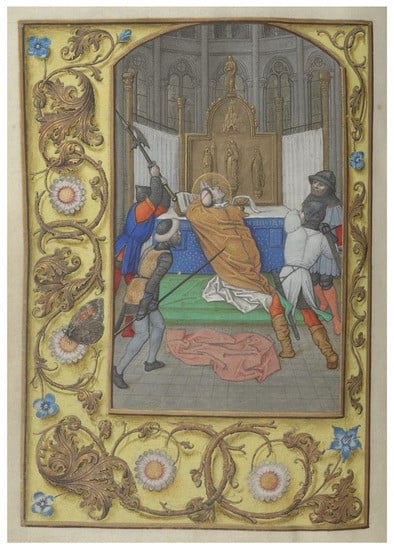
Figure 14.
The martyrdom of Thomas Becket in the ‘Hastings Hours’ c. 1483. British Library, London, Add MS 54782 fo.55v.
As noted above, Becket was increasingly shown not just at an altar but actively in the process of celebrating the Mass, which emphasised the Eucharistic similarities between his martyrdom for the rights of the Church, and Christ’s death. In the earliest years of the cult, Becket’s blood had been gathered from the floor of Canterbury Cathedral, mixed as a tincture with water, and provided to pilgrims to drink as a curative (Koopmans 2016; Jordan 2009). The overwhelmingly Eucharistic symbolism of this blood-drinking caused some theological unease, and by the fourteenth century, the ‘Thomas Water’ as it was known had been given a different interpretation by the monks as water from a nearby well that had changed its colour to that of blood, as well as to milk, at the time of the murder (Jenkins 2019, p. 37). In place of the emphasis on Becket’s blood, as here, the Christological references seem to have moved to the fully-realised setting of the Mass. In the Hastings Hours and on the instrument case this Christological iconography is reinforced by the weapons in use: the lance or spear recalling the soldier’s lance which pierced Christ’s side on the cross. This in turn had the potential to change the nature of the attackers themselves. A lance is potentially a knightly weapon if used on horseback but the barbed pikestaff shown in the Hastings Hours and on the back of the instrument case is more commonly the weapon of a foot soldier. In being shown at Mass, the identity of the blood being spilled is deliberately dualised and the change of weaponry to include items specified in the crucifixion narrative is making an intentional comparison between the martyrdom of Becket and Christ.
The Mass setting of Becket’s martyrdom also recalls depictions of the Mass of St Gregory. The later medieval desire for allegory and involvement had led to an increased interest in iconography of this miraculous Mass, and it was an important scene for artists developing ways in which the viewer is increasingly drawn into the narrative (Jacobs 1998, p. 67). In this story, St Gregory is kneeling before an altar celebrating the Mass. As he consecrates the wine to transubstantiate it into the very blood of Christ, the figure of Christ on the crucifix above the altar comes to life and steps down before the astonished Gregory to speak and to drop his own blood into the chalice. This is a reflection, a validation even, of the sanctity of Gregory as well as a vivid reminder of the miracle at each consecration. The story gained enormous currency across Europe and was a popular image for Books of Hours as well as missals. We may draw similarities between the figural arrangement of Becket’s martyrdom in the Hastings Hours and the instrument engraving, and depictions of the Mass of St Gregory based on those of Israhel van Meckenem of c. 1480–1485 [Figure 15]. In the Hastings Hours, Becket has a prominent cross on the back of his otherwise plain vestment, similar to the vestment shown on this engraving and its many imitators.
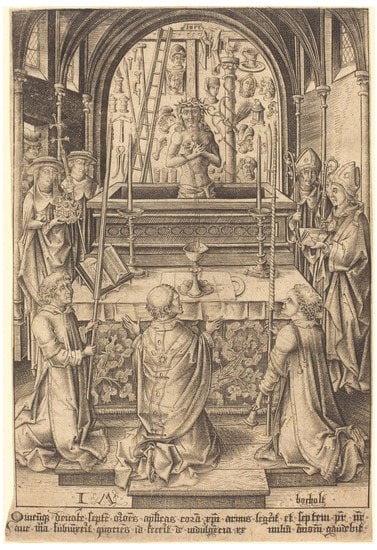
Figure 15.
Israhel von Meckenem, Mass of St Gregory c.1480–1485, National Gallery of Art, Washington DC, Rosenwein Collection.
The change of viewpoint for the depiction of Becket’s murder on the instrument case, as in the Hastings Hours, fundamentally alters our relationship with it, from observer to participant. The viewpoint employed in this Becket image changes the role of the viewer: we are no longer a detached observer watching from the sidelines; we are part of the scene, we are running in with the knights. It may be that by making some of the figures clearly non-aristocratic the user/viewer of the case is subliminally invited to become one of the four knights/attackers, or to imagine how they in their own lives might undermine and attack the Church and Christ’s sacrifice. The whole scene is simplified by presenting the attackers as the hired soldiers of an angry king, turning on the actions of the individual rather than as part of the struggle between the complex power structures of state and Church, as live an issue in the sixteenth as in the twelfth century. In the same way as fifteenth- and early-sixteenth century worshippers were encouraged towards a metaphysical engagement with the wounds and torture of Christ on the cross through close mediation on graphic and hyper-real images of his wounds and suffering, in this image we are positioned so as to become one of those on scene, with the eternal possibility of participating in the murder or attempting to prevent it. On the instrument case Edward Grim is still physically present, but awkwardly placed and an ambiguous figure. Is he cowering behind a curtain at the far side of the altar, or is he reeling wounded, having attempted to interpose himself between Becket and the attackers? In having such an image engraved on the side of the case worn next to the body, the wearer is at one with the scene, forever on the point of saving the saint or being party to his death, forever invoking the saint in his work.
The Becket engraving is placed on the side of the case which would be worn against the wearer’s body: the other side of the case is heavily decorated with coloured enamels, raised and embossed elements as well as the arms of the company and the royal arms, so must have been intended as the outward, visible side. By having the image against the body with the viewpoint of the wearer looking into the scene from the perspective of the agents there is an immediate connection between the wearer and the narrative. The duality of the wearer’s role within the scene could be intended to remind them as a surgeon how thin the line was between healing and harm and how heavily they relied on the intervention of God and the saints to influence the outcome. The choice of St Thomas as the saint whose physical representation could act as aid and intercessor is an interesting one, suggesting (as was so often the motive for choosing) that the manner of his death, particularly the violent trepanning, may relate directly to the surgical uses of the instruments contained in the case. Of all the surgeon’s interventions, the cutting of flesh and bone was the most dangerous with the ever-present risk of fatal infection. The complex correlation of iconographic details between the depiction of Becket’s martyrdom and elements of Christ’s sacrifice all centring around spilled and healing blood and the use of blades make this an unusually pertinent image for such an object. The rearrangement of the scene and the alteration of the viewpoint invest the wearer with a much more potent connection to the events depicted, placing him in the scene not parallel to it. Perhaps in this way the power of the martyrdom event and the power of the saint could be more directly felt and experienced, be more ‘potent’ and therefore more efficacious? The wearer becomes an agent in the event, immediately involved as soon as their eyes fall upon the scene, not glancing past from the side-lines.
The Becket iconography would have been unacceptable within a very few years of its creation. The order for Becket’s image to be expunged across the realm was issued by Henry VIII in 1538, probably less than a decade after the engraving was made. Some compliance with the order may be discernible in the somewhat half-hearted cross hatching which covers the Becket figure. A regular series of crossing diagonal lines extends from his head to the bottom of his chasuble, and as far as the attackers on either side, but is not seen on any other part of the box. This points to a deliberate attempt to deface the figure of the saint, but as the figure is still plainly visible it hardly fulfils the royal proclamation’s demand that his images should be ‘plucked down’ and ‘razed’. The very limited efforts at defacement may indicate a concern not to damage this useful and important object, as there would be a danger of piercing or buckling the thin silver with any concerted pressure. However, it may also speak of a desire by the owner (and perhaps even subsequent owners) to continue to access the benefits of association with a saint whose healing powers were famous across Europe and whose demise had been at the edge of a blade. The image could feasibly have been enamelled over, or otherwise occluded, but it may also have been saved by its position on the back of the case, known only to the wearer. The plainer leather carrying-case was a further level of concealment. Finally, the radical reimagining of the scene, while still clearly depicting the murder of Becket, may have meant that at a casual glance it could easily be overlooked as such given the visual cues to both Christ’s crucifixion and the Mass of St Gregory. The beauty of the piece, its continued functionality as a piece of precision-made medical kit, and the integral nature of each of its decorative components to the whole, together may have ensured its survival.
6. Conclusions
In the course of this article, we have argued that the instrument case needs to be understood in terms of both its form and its function. The contents and use of the case are not only reflected in its external decorative schema but explicated and given significance by it. To understand the unusual Becket iconography, it was necessary to view the manufacture and artistry of the case in the context of the highly innovative milieu of late medieval and Renaissance Flemish art. This in turn helps us to ‘de-centre’ Becket’s cult from the traditional focal point of the shrine at Canterbury. The iconography and cult of England’s premier medieval saint did not simply radiate out from England, but took on a life of its own across Europe in ways which, as this instrument case shows, were fed back and adopted at the highest levels of English society. In terms of thinking about other Becket objects and material culture, from ‘pilgrim souvenirs’ to the highest-status items such as these, historians and art historians should be encouraged to widen their focus beyond the shores of England.
This functional yet beautiful object was created to serve a very specific purpose and the needs of its user. Getting away from the idea of patron and artist and thinking instead about the artistic and iconographic context of its creation and, just as importantly, its use, we should not see this unusual depiction of Becket’s martyrdom as simply a late-developing iconographical variant, but in terms of the ‘pictorial syntax’ of how the image was designed and received in potentially new ways (Marrow 2006, p. 174). Radical changes in the viewpoint, the framing, the depictions of the murderers and the murder weapons were not innovations for their own sake. As noted, they were part of a more affective piety drawing the user/viewer into the scene, but they also linked directly to, and nuanced the understanding of, the function of the case which bore the image. Becket was particularly associated with healing. Yet, by placing particular emphasis on the Mass setting and the blood sacrifice of his martyrdom, the image makes connections with the contents of the box: lancets, probes, and other cutting tools which would themselves spill blood. Rather than show Becket with a head wound, his death is reimagined along Christological lines with long stabbing instruments inflicting precise wounds, again linking to the lancets and ‘spaters’ also shown on the front of the case. The viewer is invited into the scene by the breaking of the boundary by one of the attackers’ feet—is the surgeon invited to think about how he might save Becket from these potentially non-fatal wounds to the back, rather than showing him with an irreparably shattered cranium? The artist sought to re-orient the image of the martyrdom in a way that would force a new engagement with its meaning on the part of the viewer. Following this cue, we have shown how the image itself sheds new light on the dynamism and regionality of Becket’s cult on the eve of the Reformation.
Author Contributions
Conceptualization, J.J. and L.H.; writing—original draft preparation, J.J. and L.H.; writing—review and editing, J.J. and L.H. Both authors have read and agreed to the published version of the manuscript.
Funding
This research received no external funding.
Institutional Review Board Statement
Not applicable.
Informed Consent Statement
Not applicable.
Conflicts of Interest
The authors declare no conflict of interest.
Note
| 1 | The reference in the Oxford English Dictionary corpus, cited by Schroder, to a ‘plaster box... and the cysars therin’ from a late 15th century English will is misdated, and is actually from 1591. (Young 1890, p. 530). |
References
- Backhouse, Janet. 1996. The Hastings Hours. London: British Library. [Google Scholar]
- Berry, Charlotte. 2021. Guilds, Immigration, and Immigrant Economic Organization: Alien Goldsmiths in London, 1480–1540. Journal of British Studies 60: 534–63. [Google Scholar] [CrossRef]
- Borenius, Tancred. 1932. The Murderers of Thomas Becket in Popular Tradition. Folklore 43: 175–92. [Google Scholar] [CrossRef]
- Colston, Justin, and Robert Ralley. 2015. Medical Practice, Urban Politics and Patronage: The London ‘Commonalty’ of Physicians and Surgeons of the 1420s. English Historical Review 130: 1102–31. [Google Scholar] [CrossRef] [Green Version]
- Curd, Mary H. Bryan. 2010. Flemish and Dutch Artists in Early Modern England: Collaboration and Competition, 1460–1680. Aldershot: Ashgate. [Google Scholar]
- De Beer, Lloyd, and Naomi Speakman. 2021. Thomas Becket: Murder and the Making of a Saint. London: British Museum. [Google Scholar]
- De Voragine, Jacobus. 1490. Passionael Mitten Martiriologio Dat Somerstuck. Zwolle: Peter van Os. [Google Scholar]
- Decamp, Eleanor. 2016. Civic and Medical World in Medieval and Early Modern England: Performing Barbery and Surgery. Basingstoke: Palgrave Macmillan. [Google Scholar]
- Dobson, Jessie, and R. Milnes Walker. 1979. Barbers and Barber-Surgeons of London. Oxford: Blackwell. [Google Scholar]
- Duggan, Anne. 2020. Becket’s Cap and the Broken Sword. Jacques de Vitry’s English Mitre in Context. Journal of the British Archaeological Association 173: 3–25. [Google Scholar] [CrossRef]
- Gameson, Richard. 2000. The Early Imagery of Thomas Becket. In Pilgrimage: The English Experience from Becket to Bunyan. Edited by Colin Morris and Peter Roberts. Cambridge: Cambridge University Press, pp. 46–89. [Google Scholar]
- Gameson, Richard. 2020. Becket in Horae: The Commemoration of the Saint in Private Prayer Books of the Later Middle Ages. Journal of the British Archaeological Association 173: 143–73. [Google Scholar] [CrossRef]
- Good, Jonathan. 2009. The Cult of St George in Medieval England. Woodbridge: Boydell. [Google Scholar]
- Hartnell, Jack. 2017. Tools of the Puncture: Skin, Knife, Bone, Hand. In Flaying in the Pre-Modern World. Edited by Larissa Tracy. Cambridge: D. S. Brewer, pp. 20–50. [Google Scholar]
- Jacobs, Lynn. 1998. Early Netherlandish Carved Altarpieces 1380–1550: Medieval Tastes and Mass Marketing. Cambridge: Cambridge University Press. [Google Scholar]
- Jenkins, John. 2019. Replication or Rivalry? The ‘Becketization’ of Pilgrimage in English Cathedrals. Religion 49: 24–47. [Google Scholar] [CrossRef]
- Jenkins, John. 2020. St Thomas Becket and Medieval London. History 105: 652–72. [Google Scholar] [CrossRef]
- Jordan, Alyce A. 2009. The ‘Water of Thomas Becket’: Water as Medium, Metaphor, and Relic. In The Nature and Function of Water, Baths, Bathing and Hygiene from Antiquity through the Renaissance. Edited by Cynthia Kosso and Anne Scott. Leiden: Brill, pp. 479–500. [Google Scholar]
- Koldeweij, Jos. 2000. ‘Te Sente Thomas Van Canterlberghe, in Inghelant...’: Pelgrimsinsignes en Pelgrimstochten naar Thomas Becket. In Thomas Becket in Vlaandren: Waarheid of Legende? Edited by Raoul Bauer. Kortrijk: Stedelijke Musea Kortrijk, pp. 49–71. [Google Scholar]
- Koldeweij, Jos. 2005. Mediaeval Painting in the Netherlands. In Flemish Apocalypse. Edited by Nelly de Hommel and Jos Koldeweij. Barcelona: M. Moleiro, pp. 11–57. [Google Scholar]
- Koopmans, Rachel. 2016. ‘Water Mixed with the Blood of Thomas’: Contact Relic Manufacture Pictured in Canterbury Cathedral’s Stained Glass. Journal of Medieval History 42: 535–58. [Google Scholar] [CrossRef]
- Marrow, James. 2006. Scholarship on Flemish Manuscript Illustration of the Renaissance: Remarks on Past, Present, and Future. In Flemish Manuscript Painting in Context: Recent Research. Edited by Elizabeth Morrison and Thomas Kren. Los Angeles: Getty Publications, pp. 163–76. [Google Scholar]
- McNamer, Sarah. 2010. Affective Meditation and the Invention of Medieval Compassion. Philadelphia: University of Philadelphia Press. [Google Scholar]
- Morrison, Elizabeth. 2006. Iconographic Originality in the Oeuvre of the Master of the David Scenes. In Flemish Manuscript Painting in Context: Recent Research. Edited by Elizabeth Morrison and Thomas Kren. Los Angeles: Getty Publications, pp. 149–62. [Google Scholar]
- Pelling, Margaret. 1986. Appearance and Reality: Barber-Surgeons, the Body and Disease. In London 1500–1700: The Making of the Metropolis. Edited by A. L. Beier and Roger Finlay. London and New York: Longman, pp. 82–112. [Google Scholar]
- Riches, Samantha. 2000. St George: Hero, Martyr and Myth. Thrupp: Sutton. [Google Scholar]
- Rowlands, John. 1988. The Age of Dürer and Holbein: German Drawings 1400–1550. London: British Museum Publications. [Google Scholar]
- Rudy, Kathryn. 2016. Piety in Pieces: How Medieval Readers Customised their Manuscripts. Cambridge: Open Book Publishers. [Google Scholar]
- Sadler, Donna L. 2008. Touching the Passion—Seeing Late Medieval Altarpieces through the Eyes of Faith. Leiden: Brill. [Google Scholar]
- Schroder, Timothy. 2020. ‘A Marvel to Behold’: Gold and Silver at the Court of King Henry VIII. Woodbridge: Boydell. [Google Scholar]
- Smeyers, Katharina. 2000. De Moord Op Thomas Becket in de Vlaamse Miniatuurkunst. In Thomas Becket in Vlaandren: Waarheid of Legende? Edited by Raoul Bauer. Kortrijk: Stedelijke Musea Kortrijk, pp. 73–95. [Google Scholar]
- Spencer, Brian. 1998. Pilgrim Souvenirs and Secular Badges. London: Museum of London. [Google Scholar]
- Thomas, Duncan P. 2006. Thomas Vicary, Barber-Surgeon. Journal of Medical Biography 14: 84–89. [Google Scholar] [CrossRef] [PubMed]
- Thompson, Charles John Samuel. 1931. A Barber-Surgeon’s Instrument Case Of The Tudor Period. The British Medical Journal 3670: 811–12. [Google Scholar]
- Turner, D. H. 1983. The Hastings Hours. London: Thames and Hudson. [Google Scholar]
- Van der Stock, Jan. 2006. Flemish Illuminated Manuscripts: Assessing Archival Evidence. In Flemish Manuscript Painting in Context: Recent Research. Edited by Elizabeth Morrison and Thomas Kren. Los Angeles: Getty Publications, pp. 117–22. [Google Scholar]
- Verschatse, Greet. 2000. Thomas Becket in Vlaanderen: Waarheid of Legende? In Thomas Becket in Vlaandren: Waarheid of Legende? Edited by Raoul Bauer. Kortrijk: Stedelijke Musea Kortrijk, pp. 96–119. [Google Scholar]
- Wear, Andrew. 2000. Knowledge and Practice in English Medicine 1550–1680. Cambridge: Cambridge University Press. [Google Scholar]
- Wickham, Ann. 2002. The Barber’s Company’s Instrument Case. In Barber’s Historical Group Presentations: Folio 3. London: Worshipful Company of Barbers, pp. 83–93. [Google Scholar]
- Woods, Kim. 2007. Imported Images: Netherlandish Late Gothic Sculpture in England c. 1400-c. 1550. Donington: Shaun Tyas. [Google Scholar]
- Young, Sidney. 1890. The Annals of the Barber-Surgeons of London. London: Blades, East, and Blades. [Google Scholar]
Publisher’s Note: MDPI stays neutral with regard to jurisdictional claims in published maps and institutional affiliations. |
© 2021 by the authors. Licensee MDPI, Basel, Switzerland. This article is an open access article distributed under the terms and conditions of the Creative Commons Attribution (CC BY) license (https://creativecommons.org/licenses/by/4.0/).